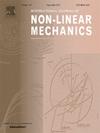Constitutive modeling of rock failure behavior under pressure conditions spanning the brittle–ductile transition
IF 3.2
3区 工程技术
Q2 MECHANICS
International Journal of Non-Linear Mechanics
Pub Date : 2025-04-17
DOI:10.1016/j.ijnonlinmec.2025.105117
引用次数: 0
Abstract
The brittle–ductile transition is a fundamental mechanical characteristic of rocks in a range of engineering applications. While various constitutive models have been proposed to predict rock failure, only a few are capable of quantitatively capturing the brittle–ductile transition. Moreover, to date, few existing models are able to uniformly describe the distinct mechanical behaviors of rocks in the brittle and ductile regimes. This paper presents a unified elastoplastic damage model capturing the mechanical behavior of rocks spanning the brittle–ductile transition. A subtly single cap-type plastic yield criterion is formulated in the effective stress space and a monotonic hardening function is introduced into the yield criterion to describe pre-peak hardening behavior accurately. The post-peak softening behavior is solely due to material damage, for which we propose a damage criterion. Unlike prevailing models, our hypothesis suggests that the damage process begins with localized cracking after reaching the peak stress, eliminating any accumulation of damage prior to the peak stress. In this context, the yield surface at peak stress state constitutes the real strength envelope. Furthermore, to accurately replicate post-peak softening behavior and brittle–ductile transition in rocks, we establish a theoretical correlation between residual damage and confining pressure. Numerical simulations are performed for three types of rock subjected to conventional triaxial compression. Comparisons between numerical predictions and test data demonstrate that the model effectively captures key features of mechanical behavior observed in these rocks. Particularly noteworthy is its ability to simulate the brittle–ductile transition.
岩石在压力条件下脆性-韧性转变破坏行为的本构模型
在一系列工程应用中,脆-韧性转变是岩石的基本力学特征。虽然已经提出了各种构造模型来预测岩石破坏,但只有少数模型能够定量捕捉脆性-韧性转变。此外,迄今为止,很少有现有模型能够统一描述岩石在脆性和韧性状态下的不同力学行为。本文提出了一种统一的弹塑性损伤模型,以捕捉跨越脆性-韧性转变的岩石力学行为。在有效应力空间中制定了一个微妙的单帽型塑性屈服准则,并在屈服准则中引入了单调硬化函数,以准确描述峰前硬化行为。峰值后软化行为完全是由于材料损伤造成的,为此我们提出了一种损伤准则。与现有模型不同的是,我们的假设认为损伤过程始于达到峰值应力后的局部开裂,从而消除了峰值应力前的任何损伤积累。在这种情况下,峰值应力状态下的屈服面才是真正的强度包络面。此外,为了准确复制岩石的峰值后软化行为和脆-韧性转变,我们建立了残余损伤与约束压力之间的理论关联。我们对三种受到传统三轴压缩的岩石进行了数值模拟。数值预测与测试数据的比较表明,该模型有效地捕捉到了在这些岩石中观察到的力学行为的关键特征。尤其值得一提的是,该模型能够模拟脆性-韧性转变。
本文章由计算机程序翻译,如有差异,请以英文原文为准。
求助全文
约1分钟内获得全文
求助全文
来源期刊
CiteScore
5.50
自引率
9.40%
发文量
192
审稿时长
67 days
期刊介绍:
The International Journal of Non-Linear Mechanics provides a specific medium for dissemination of high-quality research results in the various areas of theoretical, applied, and experimental mechanics of solids, fluids, structures, and systems where the phenomena are inherently non-linear.
The journal brings together original results in non-linear problems in elasticity, plasticity, dynamics, vibrations, wave-propagation, rheology, fluid-structure interaction systems, stability, biomechanics, micro- and nano-structures, materials, metamaterials, and in other diverse areas.
Papers may be analytical, computational or experimental in nature. Treatments of non-linear differential equations wherein solutions and properties of solutions are emphasized but physical aspects are not adequately relevant, will not be considered for possible publication. Both deterministic and stochastic approaches are fostered. Contributions pertaining to both established and emerging fields are encouraged.

 求助内容:
求助内容: 应助结果提醒方式:
应助结果提醒方式:


